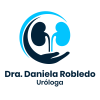Abstract
Q-tip test offers a simple approach for identifying urethral hypermobility. Considering surgical treatment, stress urinary incontinence (SUI) must be classified and the contribution of intrinsic sphincter deficiency (ISD) and/or urethral hypermobility must be determine. We believe there’s a correlation between abdominal leak point pressure (ALPP) and urethral mobility degree, and the aim of this study is to explore it using Q-tip. We conducted a prospective study, between years 2014 and 2016. Females over 18 years presenting with signs and symptoms of SUI according to the 2002 ICS Standardization of Terminology were included. Assessment was made with the International Consultation on Incontinence Questionnaire Short Form (ICIQ-SF), the Q-tip test and invasive urodynamics. Urethral mobility (UM) and ALPP were analyzed. We built two composite variables based on reported risk factors for ISD, defined as composite variable A (equal to a Q-tip test < 30° AND ICIQ-SF ≥ 10 points) and composite variable B (equal to low urethral mobility AND/OR hypoestrogenism AND/OR history of radiotherapy AND/OR previous pelvic surgery). Correlation analyzes were made according to the type of variable. A total of 221 patients were included. Incontinence was rated as moderate and severe by 65.3% and 6.8%, respectively. The analysis showed a 61.75%, 51.61% and 70.6% agreement between ALPP and UM, ALPP and composite variable A and ALPP and composite variable B respectively. Correlation and concordances were low (r = 0.155, r_s = – 0.053 and r_s = – 0.008), (rho_c = 0.036, k = 0.116 and k = 0.016). Neither the degree of UM, nor the composite variables, correlate or agree with urethral function tests in UDS, suggesting that the ALPP cannot be predicted using the Q-tip test or the ICIQ-SF for classifying patients with SUI.
Conflict of interest statement
The authors declare no competing interests.
Similar articles
-
[Usefulness of urethral descent for evaluating the type of female stress urinary incontinence].Nihon Hinyokika Gakkai Zasshi. 1999 Jan;90(1):12-9. doi: 10.5980/jpnjurol1989.90.12.PMID: 10067302 Japanese.
-
[Is there a correlation between abdominal leak pressure point, incontinence severity and quality of life in patients with stress urinary incontinence?].Arch Esp Urol. 2018 Nov;71(9):752-756.PMID: 30403377 Spanish.
-
[Intrinsic sphincter deficiency and female urinary incontinence].Prog Urol. 2015 Jun;25(8):437-54. doi: 10.1016/j.purol.2015.03.006. Epub 2015 Apr 9.PMID: 25864653 Review. French.
-
Magnetic resonance imaging in assessment of stress urinary incontinence in women: Parameters differentiating urethral hypermobility and intrinsic sphincter deficiency.World J Radiol. 2015 Nov 28;7(11):394-404. doi: 10.4329/wjr.v7.i11.394.PMID: 26644825 Free PMC article.
-
Traces: making sense of urodynamics testing–part 7: Evaluation of bladder filling/storage: Evaluation of urethral sphincter incompetence and stress urinary incontinence.Urol Nurs. 2011 Sep-Oct;31(5):267-77, 289.PMID: 22081833 Review.
References
-
- Kohorn EI. Negative Q-tip test as a risk factor for failed incontinence surgery in women. J. Reprod. Med. 1990;35:193. – PubMed
-
- Leach GE, Dmochowski RR, Appell RA, et al. Female Stress Urinary Incontinence Clinical Guidelines Panel summary report on surgical management of female stress urinary incontinence. Am. Urol. Assoc. 1997;158:875–880. – PubMed
-
- Linda C, David SP, Mauricio FN, Osborn D, Dmochowsky R. How and Why Incontinence Surgery Works. Textbook of Female Urology and Urogynecology. 4. Boca Raton: CRC Press; 2017.
-
- Schick E, Dupont C, Bertrand PE, Jolivet-Tremblay MTJ. Predictive value of maximum urethral closure pressure, urethral hypermobility and urethral incompetence in the diagnosis of clinically significant female genuine stress incontinence. J. Urol. 2004;171:1871–1875. doi: 10.1097/01.ju.0000120224.67012.39. – DOI – PubMed
-
- Iancu GPG. Predicting the outcome of mid-urethral tape surgery for stress urinary incontinence using preoperative urodynamics – a systematic review. Chir. 2014;109:359–368. – PubMed
-
- McGuire EJ. Urodynamic findings in patients after failure of stress incontinence operations. Prog. Clin. Biol. Res. 1981;78:351–360. – PubMed
-
- Crystle CD, Charme LSCW. Q-tip test in stress urinary incontinence. Obstet. Gynecol. 1971;38:313–315. – PubMed
-
- Karram MMBN. The Q-tip test: standardization of the technique and its interpretation in women with urinary incontinence. Obstet. Gynecol. 1988;71:807–811. – PubMed
-
- Fritel X, Fauconnier A, Bader G, et al. Diagnosis and management of adult female stress urinary incontinence: guidelines for clinical practice from the French College of Gynaecologists and Obstetricians. Eur. J. Obstet. Gynecol. Reprod. Biol. 2010;151:14–19. doi: 10.1016/j.ejogrb.2010.02.041. – DOI – PubMed
-
- Ghoniem G, Stanford E, Kenton K, et al. Evaluation and outcome measures in the treatment of female urinary stress incontinence: International Urogynecological Association (IUGA) guidelines for research and clinical practice. Int. Urogynecol. J. 2008;19:5–33. doi: 10.1007/s00192-007-0495-5. – DOI – PMC – PubMed









